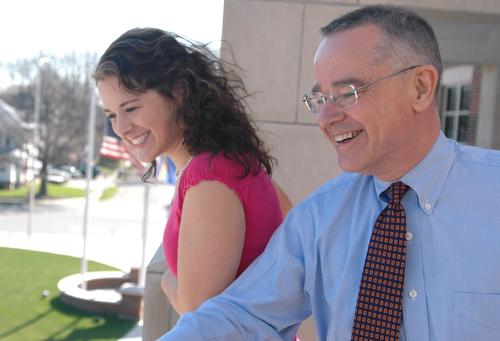UCLA reports shift in behavior trends in freshmen now versus 40 years ago

Stephanie Rank, senior in LAS, and her father Joe, alumnus and Vice President of Membership at the Alice Campbell Alumni Center, look down from the balcony at the Alumni Center on April 18. Beck Diefenbach
Apr 23, 2007
Last updated on May 12, 2016 at 11:22 a.m.
Imagine women always wearing skirts to class and being required to be in their residence halls for curfew at 11 p.m. on weekdays and 1 p.m. on weekends. Imagine men wearing suit coats and ties to a football game or carrying their books to class because backpacks were “uncool.”
The University of California at Los Angeles recently released a report, “The American Freshman: Forty-Year Trends 1966-2006,” outlining the differences between entering students today and 40 years ago.
For Joe Rank, vice president of membership for the Alumni Association, and his daughter, Stephanie Rank, senior in LAS, campus life at the University has visibly changed in 40 years.
“Every male had a blue blazer,” Rank said. Rank graduated from the University in 1969 with a degree in advertising. He got his master’s degree from the University in 1973.
Get The Daily Illini in your inbox!
He said that there were three television networks that everyone watched, and if anyone was listening to the radio they were all listening to the same song.
“Now everyone’s listening to something different,” Rank said.
Besides which radio station they listen to, according to the UCLA report, students are becoming more polarized in certain areas. Today, more students label themselves as either liberal or conservative with the number of moderates decreasing.
Stephanie Rank suggested that still some aspects of student life are uniform.
“During the winter, you see the girls with their North Face blazers and UGG boots,” Stephanie Rank said. “It’s nearly impossible to see kids without iPods.”
Both Stephanie Rank and her father said that it seems students are still more individualized today than 40 years ago.
In the ’60s, since women had a curfew, each gender spent more time with each other in the residence halls, Rank said.
“That was the time when there was bonding, getting to know each other,” Rank said.
Back then, statistically, bonding between races was not very evident. In 1971, according to the UCLA report, 90.9 percent of first-time, full-time freshmen were white, while today it is 76.5 percent.
Not only were there disparities between races, but the roles of men and women were different.
The UCLA report suggests that gaps favoring men over women persist today in the physical and computer sciences, but no longer in mathematics.
In one of Rank’s old yearbooks, many women majored in “home economics,” a domestic major no longer offered to students. Rank said that in the ’60s, women were placed on a pedestal and men would commonly serenade them outside their dorm rooms.
“It would be nice to have some of those traditions,” Rank said. “People were more polite back then.”
Stephanie Rank’s response was that overt stereotyping was much more prevalent then, hinting that people were not necessarily more polite.
According to the UCLA study, it is expected that about two-thirds of college students today socialize with people of a different race or ethnicity. In a breakdown of the report by Inside Higher Education, this percentage contrasts with students’ views on racism and their institutions’ obligation to foster interracial dialogue.
A little over one third of students today believe that promoting racial understanding is “essential” or “very important.”
“I think it would be nice to have some of the old traditions and patterns,” Joe began, “(with) the perspective (and) cultural awareness (of) today,” Stephanie finished.





